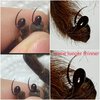Paul Osullivan
Arachnosquire
- Joined
- Dec 18, 2019
- Messages
- 108
Hi Ooya. I really appreciate you going to these lengths to show more of your spiders. It is very interesting discussing these spiders. I did initially think your spiders were h. laticeps, but sometimes pictures can show things that made believe you had a Hercules female, but now I'm not so sure.
I have looked closely at your male and I'm sure you can see the differences between my hercules and your spider. Hercules having silmmer shorter back legs, longer thicker front legs, slender femurs and a deeper black color. It's likely your 3 males were all from the same eggsack and all matured at different times and sizes. They all seem to have the longer back legs, with bigger femurs and lighter color.






The bulbs do look to be the same shape and size to each other and look alike to the sketch in A. Smith's book of H. laticeps in my opinion. Your right hercules were never collected or described. We can see the bulb is slender and longer in this species compared to H. laticeps.

I have looked closely at your male and I'm sure you can see the differences between my hercules and your spider. Hercules having silmmer shorter back legs, longer thicker front legs, slender femurs and a deeper black color. It's likely your 3 males were all from the same eggsack and all matured at different times and sizes. They all seem to have the longer back legs, with bigger femurs and lighter color.






The bulbs do look to be the same shape and size to each other and look alike to the sketch in A. Smith's book of H. laticeps in my opinion. Your right hercules were never collected or described. We can see the bulb is slender and longer in this species compared to H. laticeps.


Last edited:




































































